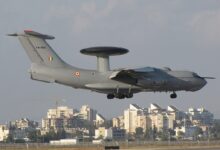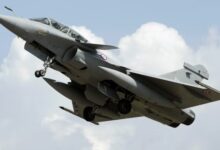LCA Tejas Program Gains Momentum With First Series Production Of LCA Trainer Takes To The Skies

- The Indian Air Force will be able to do more air-to-air and air-to-ground missions because the plane has modern characteristics, such as weaponry systems.
- The successful first flight of the LCA Tejas Trainer is a new step in India's attempts to become more self-reliant and to improve its defenses.
The first-ever series production standard LCA Trainer (LT 5201) made by Hindustan Aeronautics Limited (HAL) took its first flight on April 5, 2023, from HAL airport. This was a big step forward for India’s defense industry.
The plane flew for almost 35 minutes without any problems, which is a big step forward for the country. The successful flight is a new step in India’s attempts to become more self-sufficient and to improve its defenses. This success shows how hard the HAL LCA Tejas team has been working.
LCA Tejas Trainer: An Overview
The LCA Tejas program started in the 1980s with the goal of replacing India’s old MiG-21 fighters. However, it has since become part of a larger initiative to update the country’s fleet. The HAL Tejas is a single-engine, delta-wing, light multirole fighter for the Indian Air Force and Indian Navy. It was made by the Aeronautical Development Agency (ADA) and the Aircraft Research and Design Centre (ARDC) of Hindustan Aeronautics Limited (HAL).
The LCA Tejas Trainer is a trainer plane for the Indian Air Force. It has two seats. It is one of the three versions of the HAL Tejas fighter plane that are made for sale. The other two are the Tejas Mark 1 and the Tejas Mark 1A. The plane is 13.2 meters long, 8.2 meters wide, and 4.4 meters high. The most it can weigh when taking off is 13,500 kg, and it is powered by an 85KN GE F404-IN20 engine.
The plane can go as fast as Mach 1.6 and can fly as high as 50,000 feet above the ground. It has 9 weapon hard points. The Tejas Mark 1A is an enhanced version of the Mark 1. It has an electronic warfare system, an advanced electronically scanned array (AESA) radar, beyond visual range (BVR) missiles, and a network warfare system with software-defined radios. (SDR).
Our thanks to ADA, DGAQA, CEMILAC and others involved in this success. @DefProdnIndia @SpokespersonMoD @gopalsutar pic.twitter.com/m2iiwDFmxr
— HAL (@HALHQBLR) April 5, 2023
This is a big deal because the LCA Tejas Trainer is a key part of India’s program to update its fleet. This program has been going on for many years. The first flight of LT 5201 going well is an important step in this program because it represents the start of making the LCA Tejas Trainer series.
The LCA Trainer will be used to teach Indian Air Force pilots how to fly and will assist the country build up its own aviation skills. This plane will give Indian pilots the training they need to fly modern fighter planes, and it will also be used to train pilots for other Indian fighter planes.
Gp Capt Venu (Retd) and Wg Cdr (Retd) Awasthi, both veteran HAL test pilots, flew the LT 5201 on its first flight. The Aeronautical Development Agency (ADA), the Directorate General of Aeronautical Quality Assurance (DGAQA), the Centre for Military Airworthiness and Certification (CEMILAC), and other people who worked on this project helped make it a success.
One LCA Tejas Trainer plane costs about Rs. 280 crore, which makes it the least expensive four-and-a-half-generation plane that can be bought. Already, HAL has gotten eight orders for the LCA Trainer, which will be delivered quickly. Several countries are interested in buying this plane because of how affordable it is, which might help India’s defense exports in a big way.
This important step by the HAL LCA team lends a boost to other training planes that HAL is making, like the Hindustan Turbo training 40. (HTT-40).
Developing Indigenous Capabilities
The LCA Tejas Trainer will be made in a series, which will help India build up its own aviation sector and give Indian pilots the expertise they need to fly fighter jets in a more efficient and safe way.
The LCA Tejas Trainer is also a key part of India’s “Make in India” program, which aims to increase manufacturing in India and lessen its reliance on foreign suppliers. More than 55% of the parts used to make the LCA Tejas Trainer are made in India.
The successful first flight shows that the Indian Air Force has faith in the LCA Tejas Trainer, which will be a key part of the country’s defense. The Indian Air Force will be able to do more air-to-air and air-to-ground missions because the plane has modern characteristics, such as weaponry systems.
When the first LCA Trainer that is ready for production takes off for the first time, it is a big deal for the country, the aviation sector, and the LCA Tejas Program. It shows how hard the Indian engineers and scientists who worked on the initiative worked and how much they cared about the project.
The successful first flight of the LCA Tejas Trainer is a new step in India’s attempts to become more self-reliant and to improve its defenses.







Facebook Comments